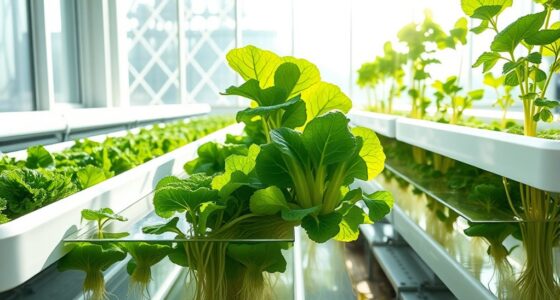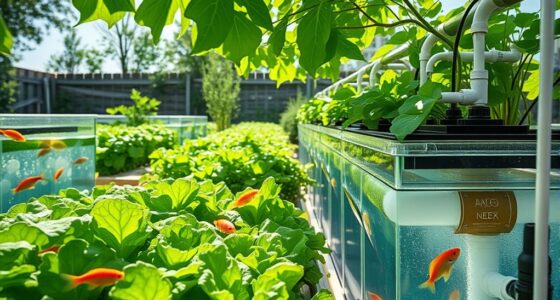To successfully garden this fall in balcony containers, choose hardy plants like kale, pansies, and chrysanthemums that tolerate colder temperatures. Arrange your containers thoughtfully, matching plant sizes and light needs, and select insulated pots with good drainage. Incorporate warm fall colors and textures, and prepare nutrient-rich soil with regular fertilizing. Protect plants from frost with covers and windbreaks, and consider overwintering perennials indoors. Explore more tips to craft a vibrant, season-long balcony display.
Key Takeaways
- Choose hardy, frost-tolerant plants like kale, pansies, and ornamental grasses suited to your hardiness zone.
- Select containers with drainage and insulation, using materials like plastic or glazed pots for winter protection.
- Plan your layout by assessing sunlight exposure and grouping plants with similar water and light needs.
- Incorporate seasonal accents such as pumpkins, gourds, and warm-colored foliage for a festive fall look.
- Adjust watering frequency, insulate containers, and protect plants from cold snaps to ensure healthy fall growth.
Selecting Hardy Plants for Autumn

As autumn arrives, choosing hardy plants guarantees your balcony containers stay vibrant and resilient through the colder months. Hardy plants like kale, spinach, and collards thrive in autumn, tolerating frost and cold temperatures, making them perfect for balcony containers.
Choosing hardy plants like kale and spinach ensures your balcony remains vibrant through autumn and winter.
Perennials such as sedum and ornamental grasses remain resilient through winter and can stay in containers for multiple seasons, saving you time and effort.
Opt for plants with thicker, waxy foliage or woody stems, like rosemary or small shrubs, which withstand cooler weather better.
Fall-hardy flowering plants like chrysanthemums and pansies add seasonal color without sacrificing durability.
Always select plants suited to your specific hardiness zone to ensure they survive winter and flourish in your balcony environment.
Planning Your Fall Container Layout
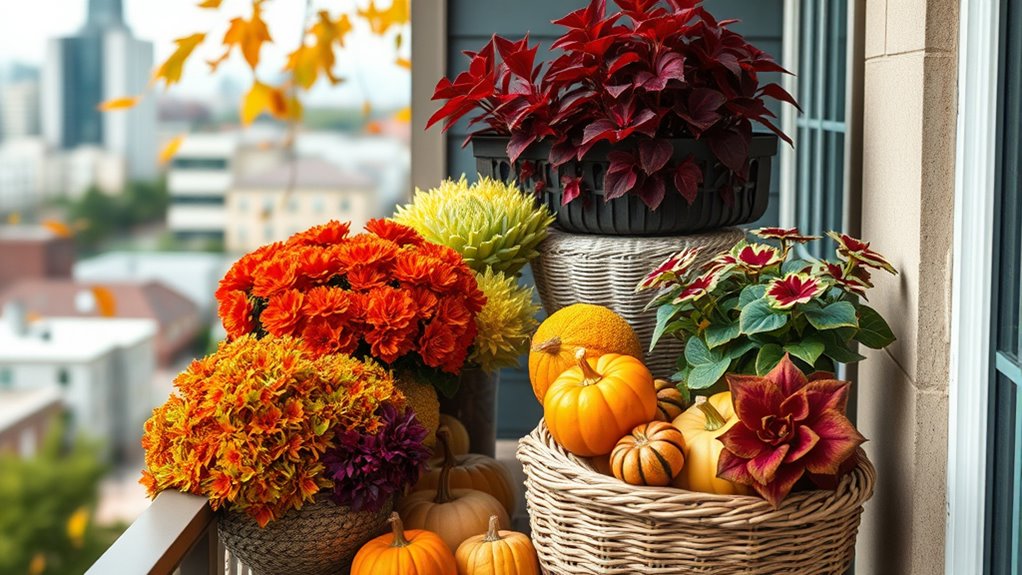
Start by evaluating your balcony’s sunlight and microclimate to choose the right fall plants. Sketch a layout that balances heights, textures, and colors for visual appeal and seasonal charm. Group plants with similar water and light needs to make caring for them easier and more effective. Incorporating remote work considerations, such as flexible watering schedules or maintenance time, can help maintain your container garden efficiently. Additionally, understanding contrast ratio can guide your selection of plants that stand out and create striking visual effects. Recognizing plant growth habits can also assist in arranging your containers to accommodate mature sizes and prevent overcrowding, while considering dog names can add a personal touch to your gardening space. Being aware of the horsepower of electric dirt bikes can inspire you to select robust and healthy plants that thrive in your environment.
Selecting Fall Plants
Choosing the right fall plants is key to creating a vibrant and resilient balcony container display. Your plant selection should focus on plants with striking fall foliage, like ornamental cabbages, mums, and kale, to add seasonal color. Incorporating self-watering pots can help maintain consistent moisture levels, especially as temperatures drop. Consider your balcony’s sunlight exposure to pick sun-loving or shade-tolerant options. Incorporate a variety of textures and heights—trailing, upright, and low-growing plants—to keep the container garden visually interesting. Opt for hardy, cold-tolerant varieties such as pansies, winter-blooming heather, and ornamental grasses, ensuring your plants thrive through the season. Group plants with similar watering and light needs to promote healthy growth. Proper drainage is essential to prevent overwatering and root rot during colder months. Additionally, selecting plants adapted to local climate conditions will enhance their resilience and longevity throughout fall. Understanding plant hardiness zones can help you choose species that are more likely to survive and flourish in your specific area. Choosing plants with proven cold tolerance can make a significant difference in their ability to withstand early frosts. Thoughtful plant selection guarantees a beautiful, long-lasting fall container garden that shines with seasonal vibrancy.
Arranging for Space
Properly arranging your fall container garden begins with measuring your balcony space and creating a scaled layout. This helps you determine the best container placement, considering sunlight, wind, and access. For small gardens, maximize vertical space using wall-mounted planters or tiered stands, freeing up floor area for more containers. Group plants with similar needs—light, water, and temperature—to simplify care and promote healthy growth. In addition, understanding cultural nuances can help you select plants that thrive in your local climate and cultural environment, ensuring your garden’s success. Incorporating multi-functional furniture can also optimize your limited space by providing both seating and storage options. Additionally, researching vetted Halloween products can inspire themed container decorations or accessories to enhance your fall garden display. Incorporating drought-tolerant plants can help reduce watering needs during the fall season when rainfall may be less frequent. Incorporate a mix of container sizes and shapes to add visual interest and accommodate plants at different stages of growth. Position taller plants at the back or center, with trailing or low-growing plants in front, creating a balanced look. Additionally, considering the water features in nearby water parks can inspire your container water elements, adding a fun and thematic touch to your fall garden. Thoughtful space arrangement guarantees your container gardens look attractive and thrive throughout the fall season.
Choosing the Right Containers for Fall Planting
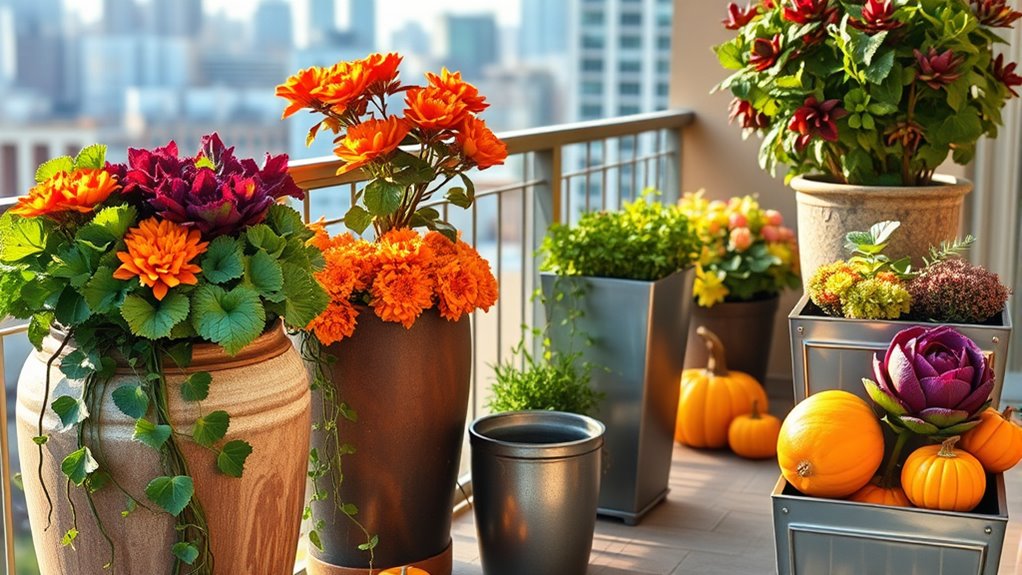
When selecting containers for fall planting on your balcony, it’s vital to prioritize those with drainage holes to prevent water from accumulating and causing root rot during rainy weather. Proper drainage is essential for healthy root systems. Additionally, incorporating glycolic acid products into your skincare routine can help improve skin texture and radiance, ensuring you look your best throughout the season. Choose materials like glazed or plastic pots, which retain moisture and insulate against cooler temperatures. Avoid unglazed terracotta or ceramic containers in winter, as they’re prone to cracking from freeze-thaw cycles. Selecting containers with adequate insulation can help protect roots from temperature fluctuations. Using containers with drainage capabilities ensures excess water can escape, preventing waterlogging and promoting healthy growth. Opting for containers with proper size and depth—at least 12-18 inches deep—is crucial to support the root development of your fall plants. Lightweight materials like fiber or resin are also good choices, making it easier to move containers as weather conditions change. Incorporating aesthetic wall organization solutions can also optimize space and add visual interest to your balcony garden. Selecting the right containers ensures your plants stay healthy and thrive throughout the fall season.
Incorporating Fall Colors and Textures
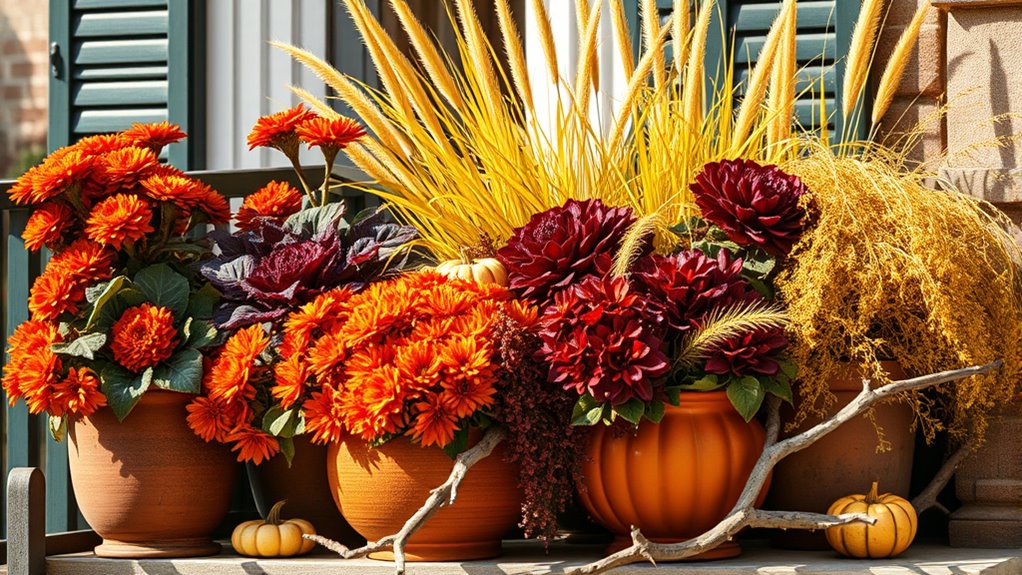
To create a vibrant fall display, start by choosing warm-toned foliage plants like Heuchera and bronze ferns that bring rich color to your containers. Mix textures by pairing ornamental cabbages with spiky grasses or broad-leaved hostas to add visual interest. Incorporate self watering plant pots to ensure your plants stay hydrated throughout the season without frequent watering. Finish with seasonal accents like pumpkins or gourds to layer textures and deepen the autumnal feel.
Warm Fall Hues
Embracing warm fall hues in your balcony containers instantly creates a cozy, inviting atmosphere. Incorporate fall hues like deep reds, burnt oranges, and rich golds with seasonal plants such as chrysanthemums, ornamental cabbages, and sedge grasses. These colors evoke seasonal warmth and brighten your container gardening effort. To add visual depth, include textured foliage like bronze-tipped ferns and purple-leaved Heuchera, which contrast beautifully with vibrant blooms. Mixing flowering plants with colorful berries or ornamental peppers for lively accents that enhance your warm color palette. Consider plants with foliage that changes color in fall, like maple-leafed vines or deciduous shrubs, to create dynamic visual interest. Incorporating Gorse plants that thrive in cooler weather can extend your garden’s beauty and productivity. Pairing these with bronze-colored pots and decorative accents amplifies the cozy, inviting feel of your balcony garden. Additionally, incorporating plants that support pollinators, such as bees, can promote a healthy and vibrant balcony ecosystem. Utilizing sound design techniques such as layering ambient sounds can also enhance the outdoor experience on your balcony, making it feel even more inviting and serene.
Textured Foliage Mix
Adding variety to your balcony containers with textured foliage amplifies the visual appeal of fall plantings. Incorporate foliage plants with diverse plant textures and seasonal textures to create depth and interest. Use rich fall colors like deep reds, burnt oranges, and bronze tones in plants such as Heuchera, Caladium, and Persian shield. Mix smooth, glossy leaves with rough, fibrous foliage—pair hostas with textured ferns or Japanese maples for contrast. Vary growth habits—upright, trailing, or mounding—to add layers and dimension. Including plants like fuzzy lamb’s ear or spiky ornamental grasses alongside softer-leaved plants enhances tactile and visual balance. This approach keeps your container arrangements lively and seasonally vibrant.
| Plant Type | Texture/Color |
|---|---|
| Ornamental grasses | Spiky, seasonal textures |
| Heuchera | Deep reds, mounded foliage |
| Ferns | Textured, fibrous leaves |
| Caladium | Burnt orange, broad leaves |
Seasonal Plant Pairings
Incorporating fall colors and textures into your balcony containers creates a vibrant and dynamic display that captures the essence of the season. Seasonal plant pairings like warm-hued foliage plants—such as Heuchera ‘Sugar and Spice’ and bronze sedge—bring rich fall tones to your fall container arrangements.
Combining ornamental cabbages and kale with purple and red-leafed coleus offers contrasting textures and vibrant seasonal color. Use textured plants like Japanese forest grass or variegated ivy alongside flowering mums to add visual interest and layered depth.
Pair deep orange or burgundy ornamental peppers with bright yellow marigolds or pansies for a striking fall-themed color palette. Selecting plants with different leaf shapes and textures enhances your balcony garden design, creating a lush, tactile, and colorful fall display.
Preparing Soil and Fertilizing for Fall Growth
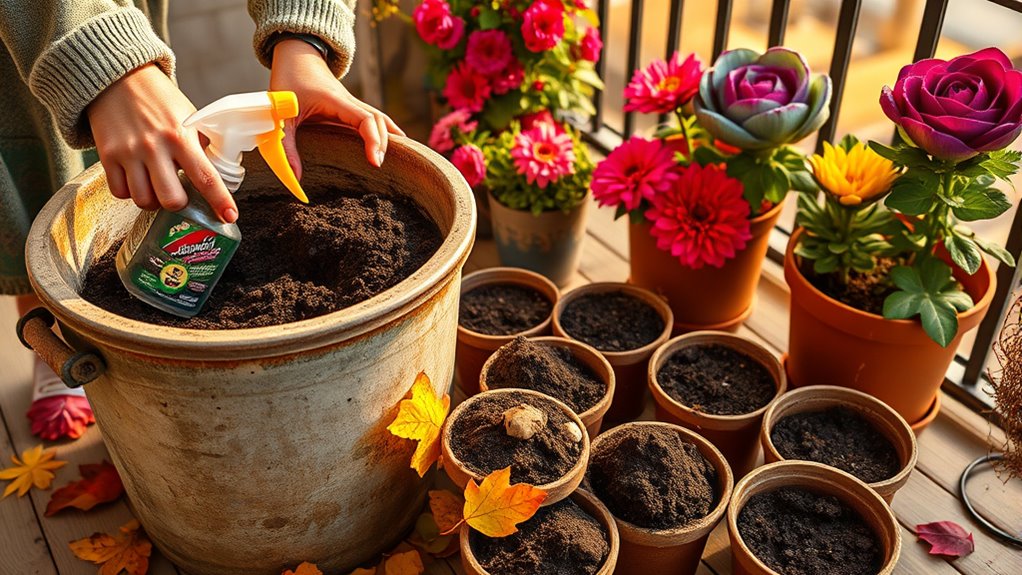
To guarantee your balcony containers support healthy fall growth, start by selecting a nutrient-rich, well-draining potting mix blended with compost and organic matter. This soil provides the essential nutrients and moisture retention your plants need.
Incorporate slow-release fertilizers or organic amendments like fish bone meal or blood meal into the soil at planting; this ensures a steady supply of nutrients throughout the season.
Adjust the soil’s pH according to your plants’ preferences—acidify with peat moss for acid-loving plants or keep it neutral for most vegetables and ornamentals.
To maintain optimal soil health, regularly amend it with liquid fertilizers such as fish emulsion or seaweed extract every 2-3 weeks during active fall growth.
Proper drainage in your container prevents waterlogging and nutrient leaching, supporting vigorous plant development.
Planting Tips for Late Season Success
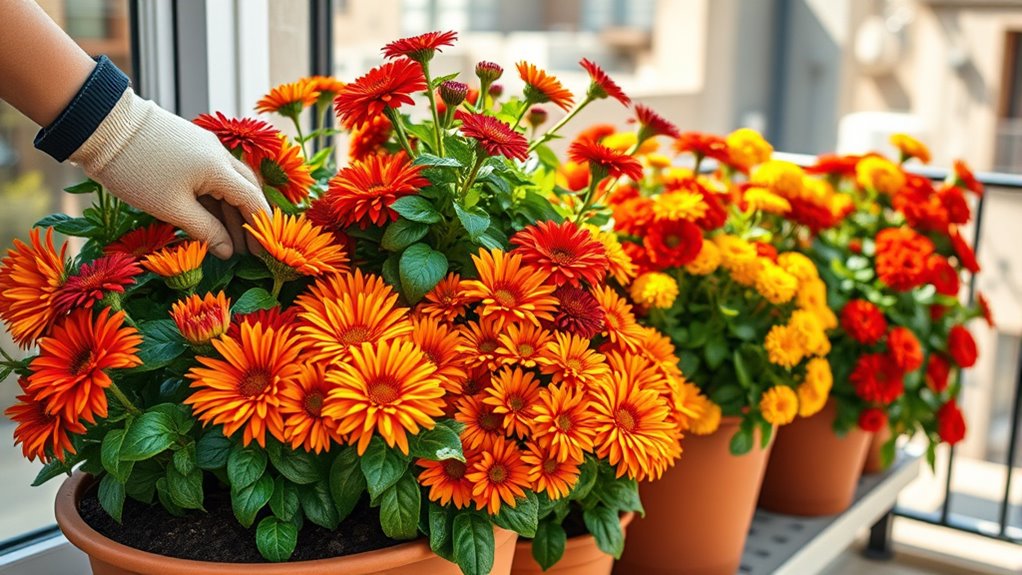
As the season winds down, selecting the right plants is vital to late-season success on your balcony. Focus on frost-tolerant varieties like kale, spinach, and collards, which can withstand early frosts and thrive in container gardening.
Choosing frost-tolerant greens like kale and spinach ensures a successful late-season balcony harvest.
Incorporate quick-maturing vegetables such as radishes, turnips, and microgreens to maximize your harvest before the first hard freeze. Herbs like cilantro and mustard greens also flourish in cooler temperatures and can be harvested into fall.
Use well-draining, nutrient-rich soil and keep moisture consistent to support healthy growth. Timing is essential—schedule your planting based on your zone’s first expected frost date to guarantee crops mature in time.
Proper plant selection and care will boost your chances of a successful late-season harvest.
Watering and Maintenance in Cooler Months
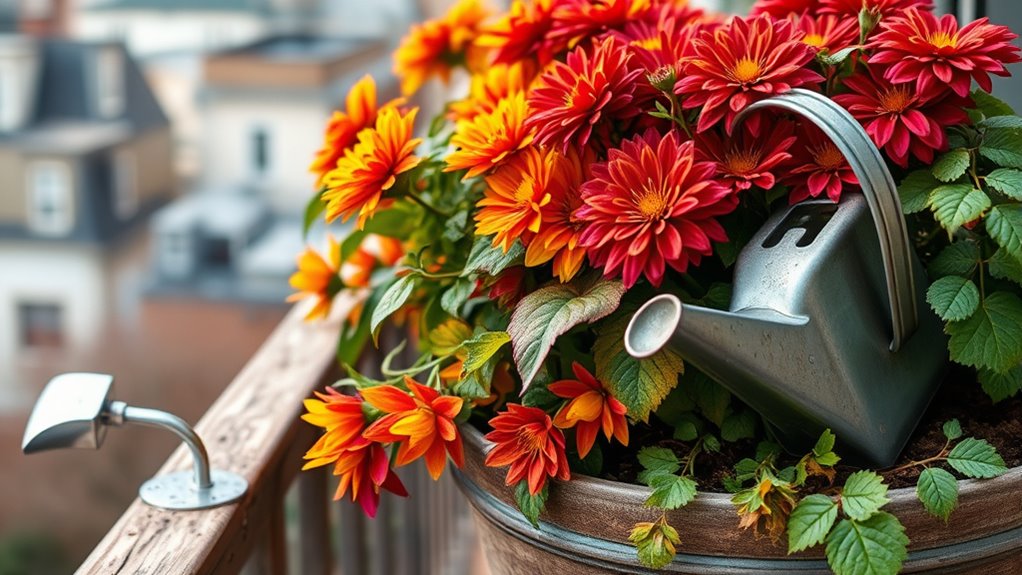
During cooler months, you should reduce how often you water your containers, typically to once every 2-3 days, and always check soil moisture first.
Protect your plants from cold snaps by moving containers to sheltered spots or using insulation, and consider installing drip irrigation for consistent watering.
Remember to guarantee proper drainage to prevent waterlogging as evaporation slows down.
Adjust Water Frequency
When temperatures drop in fall, you should reduce how often you water your balcony plants to prevent overwatering and root rot. Cooler weather slows evaporation, so plants need less frequent watering—typically every 3 to 7 days. Regularly check soil moisture, watering only when the top inch feels dry. Use well-draining soil mixes and containers with drainage holes to avoid excess water retention. If you experience heavy rainfall, consider waterproof containers or adding drainage materials to prevent waterlogging. Remember, microclimate factors like wind and sunlight affect watering needs, so adjust accordingly. Here’s a quick guide:
| Container Size | Soil Moisture Level | Recommended Watering Frequency |
|---|---|---|
| Small | Slightly moist | Every 3-4 days |
| Medium | Slightly dry | Every 4-5 days |
| Large | Dry | Every 5-7 days |
| Very large | Slightly moist | Every 4-6 days |
| Outdoor | Varies | Monitor soil moisture |
Protect From Cold
To protect your balcony plants from the cold, start by adjusting your watering routine to prevent overwatering, which can lead to root rot in damp, chilly conditions. Maintaining proper soil moisture is essential; water less frequently as temperatures drop, ensuring the soil stays moist but not waterlogged.
Water early in the day so foliage can dry, reducing fungal disease risk during cooler, damp weather. Use mulch or straw on top of containers to insulate roots and help retain soil moisture during freezing or frosty nights.
Drain excess water from saucers and trays after watering to prevent overwatering and root damage caused by reduced evaporation. Remember, container material affects watering needs—glazed or plastic pots hold moisture longer, so adjust your watering schedule accordingly to protect from cold.
Use Drip Irrigation
Using a drip irrigation system in cooler months helps you deliver water efficiently and consistently to your balcony plants. This system targets watering containers directly at the soil’s base, reducing evaporation and runoff during fall gardening.
Adjust your drip timers to provide deep, less frequent watering, accommodating slower plant growth and lower evaporation rates. Use emitters with pre-set flow rates, such as 1-2 gallons per hour, to prevent overwatering in cooler weather.
Regularly check the drip lines and emitters for clogs or leaks, as condensation and debris can cause blockages. Mulching containers before watering helps retain soil moisture, and combining mulch with drip irrigation maximizes water efficiency.
This approach ensures your balcony plants stay healthy and well-hydrated throughout fall.
Protecting Plants From Wind and Frost
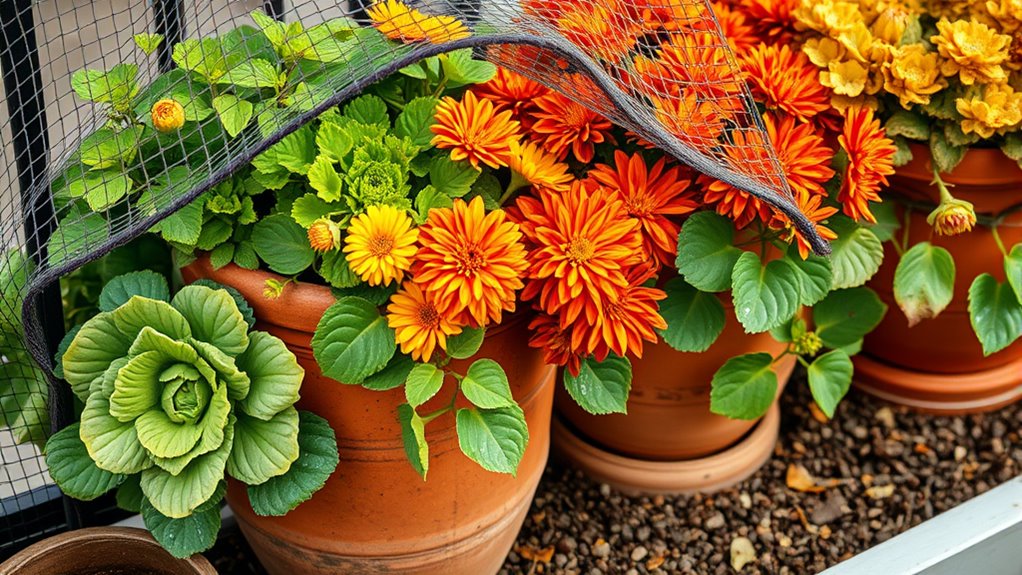
Protecting your balcony plants from wind and frost is essential to keep them healthy through the colder months. For wind protection, choose wind-resistant plant varieties and place them near walls or structures to reduce exposure. Position taller or wind-sensitive plants in sheltered spots or behind windbreaks like screens or fences to minimize physical stress.
To prevent frost damage, cover vulnerable plants with frost cloths, burlap, or bubble wrap during cold nights. Mulch heavily around the base of your plants to insulate roots and retain soil warmth. Installing temporary barriers such as lattice panels or outdoor curtains can further reduce wind speed and shield your plants from harsh gusts.
These steps help ensure your balcony garden survives and thrives through fall and winter.
Overwintering Tips for Potted Perennials and Shrubs
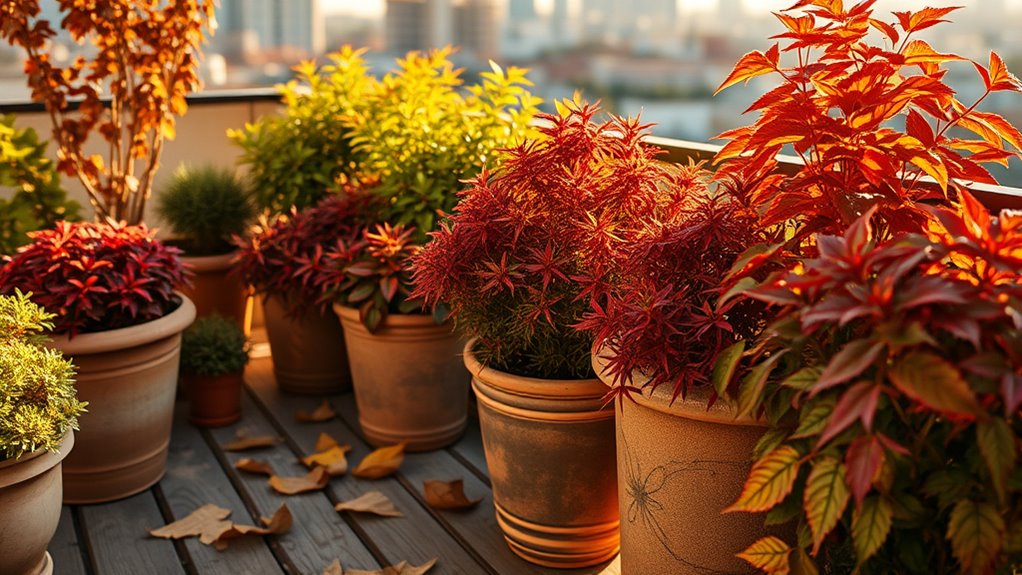
Moving potted perennials and shrubs to a sheltered spot is the best way to shield them from harsh winter conditions. Overwintering these plants indoors or in a frost-free garage helps prevent cold damage.
Mulch the top of containers with straw, bark, or compost to insulate roots and retain soil moisture. Choose hardy, cold-tolerant varieties, and opt for containers made of insulating materials like plastic or glazed ceramic to improve survival chances.
Reduce watering in winter, as plants enter dormancy and need less moisture; ensure containers drain well to prevent root rot.
For tender perennials and shrubs, prune back growth before overwintering and wrap containers with burlap or insulating sleeves to minimize frost damage.
Proper overwintering guarantees your potted perennials and shrubs survive until spring.
Creative Ideas for Fall Balcony Garden Displays

To create a stunning fall balcony garden display, incorporate vibrant seasonal colors with plants like mums, ornamental cabbages, and kale that thrive in cooler weather. Use these plants in your balcony containers to bring bold hues and texture.
Layer greenery such as nandina or bronze-tipped ferns with bright berries or ornamental peppers to add depth and visual interest.
Add depth with nandina, bronze ferns, berries, and ornamental peppers for seasonal visual interest.
Enhance your display with decorative elements like pumpkins, gourds, or miniature hay bales, making your balcony more inviting and festive.
Select plants with textured foliage, such as sedge or dusty miller, to add contrast and durability.
Creating container groupings with varying heights and colors helps achieve a cohesive, eye-catching fall balcony garden that celebrates the season’s beauty.
Frequently Asked Questions
What Container Plants Are Good in the Fall?
You’re wondering which container plants thrive in fall. You should choose hardy perennials like sedum, ornamental grasses, and pansies that handle cooler weather.
Add seasonal foliage plants such as coleus, sweet potato vine, and heuchera for vibrant color.
Consider flowering options like chrysanthemums and kalanchoe for continuous blooms.
Drought-tolerant plants like succulents and sedum also work well.
Make sure to pick plants with similar light and water needs for a healthy, long-lasting display.
How to Arrange Plant Pots on Balcony?
Oh, the grand art of balcony plant arrangement—truly a puzzle for the ages! You should place taller plants at the back or center, so they don’t block your view (or your neighbor’s).
Group similar light and water needs together for easy care.
Use stands, hanging baskets, or wall containers for vertical flair, and shield delicate plants near walls.
Balance color and texture for that Instagram-worthy balcony everyone envies.
What Plants Are Best for an Apartment Balcony?
You’re wondering what plants are best for your apartment balcony. Focus on compact, low-maintenance varieties like herbs such as parsley and cilantro, or vegetables like kale and spinach that tolerate cooler weather.
Choose hardy plants like succulents for easy care, and select options suited to your sunlight exposure—shade-loving ferns or sun-loving tomatoes.
Use containers with drainage, and mix foliage, flowers, and edibles to create an appealing, functional space.
What to Grow in Balcony Planters?
Sure, you could grow a jungle of exotic plants, or you could just stick with hardy fall favorites. Think kale, spinach, and Swiss chard—they’re tough enough to survive chilly days.
Herbs like cilantro and parsley thrive too. Add some colorful mums or ornamental cabbage for flair.
Keep in mind, matching light and water needs makes everything easier. So, go for the plants that love your balcony’s vibe and season.
Conclusion
As you embrace fall planting on your balcony, remember it’s like tending a delicate mosaic—each choice adds to its vibrant beauty. I once watched a simple container burst with color after careful planning, proving that even in cooler months, your balcony can be a thriving canvas. With patience and attention, you’ll create a cozy haven that blooms beautifully through autumn’s chill, reminding you that every small effort crafts a stunning, resilient garden.



